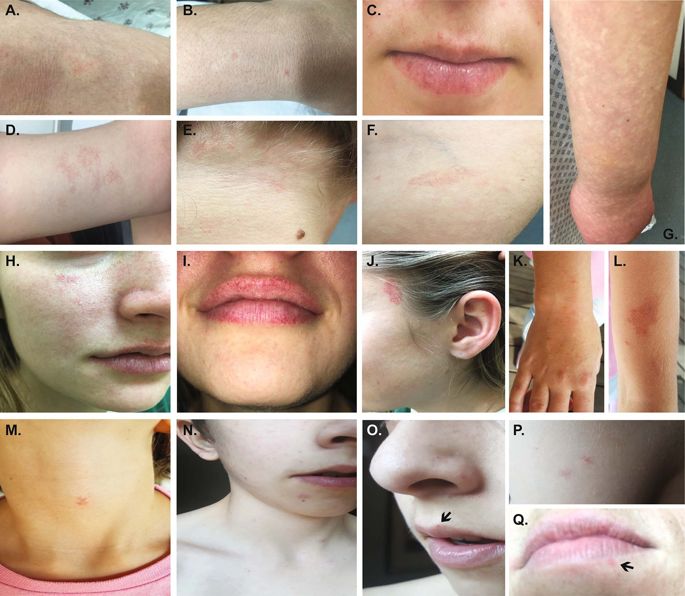当前位置:
X-MOL 学术
›
Genet. Med.
›
论文详情
Our official English website, www.x-mol.net, welcomes your
feedback! (Note: you will need to create a separate account there.)
Phenotype of CM-AVM2 caused by variants in EPHB4: how much overlap with hereditary hemorrhagic telangiectasia (HHT)?
Genetics in Medicine ( IF 6.6 ) Pub Date : 2019-02-14 , DOI: 10.1038/s41436-019-0443-z Whitney L Wooderchak-Donahue 1, 2 , Gulsen Akay 1, 3 , Kevin Whitehead 4 , Eric Briggs 1 , David A Stevenson 5 , Brendan O'Fallon 1 , Matthew Velinder 6 , Andrew Farrell 6 , Wei Shen 1 , Emma Bedoukian 7 , Cara M Skrabann 7, 8 , Richard J Antaya 9 , Kate Henderson 10 , Jeffrey Pollak 10 , James Treat 11 , Ronald Day 12 , Joseph E Jacher 13 , Mark Hannibal 13 , Kelly Bontempo 14 , Gabor Marth 6 , Pinar Bayrak-Toydemir 1, 2 , Jamie McDonald 2, 15
Genetics in Medicine ( IF 6.6 ) Pub Date : 2019-02-14 , DOI: 10.1038/s41436-019-0443-z Whitney L Wooderchak-Donahue 1, 2 , Gulsen Akay 1, 3 , Kevin Whitehead 4 , Eric Briggs 1 , David A Stevenson 5 , Brendan O'Fallon 1 , Matthew Velinder 6 , Andrew Farrell 6 , Wei Shen 1 , Emma Bedoukian 7 , Cara M Skrabann 7, 8 , Richard J Antaya 9 , Kate Henderson 10 , Jeffrey Pollak 10 , James Treat 11 , Ronald Day 12 , Joseph E Jacher 13 , Mark Hannibal 13 , Kelly Bontempo 14 , Gabor Marth 6 , Pinar Bayrak-Toydemir 1, 2 , Jamie McDonald 2, 15
Affiliation

|
PURPOSE
EPHB4 variants were recently reported to cause capillary malformation-arteriovenous malformation 2 (CM-AVM2). CM-AVM2 mimics RASA1-related CM-AVM1 and hereditary hemorrhagic telangiectasia (HHT), as clinical features include capillary malformations (CMs), telangiectasia, and arteriovenous malformations (AVMs). Epistaxis, another clinical feature that overlaps with HHT, was reported in several cases. Based on the clinical overlap of CM-AVM2 and HHT, we hypothesized that patients considered clinically suspicious for HHT with no variant detected in an HHT gene (ENG, ACVRL1, or SMAD4) may have an EPHB4 variant.
METHODS
Exome sequencing or a next-generation sequencing panel including EPHB4 was performed on individuals with previously negative molecular genetic testing for the HHT genes and/or RASA1.
RESULTS
An EPHB4 variant was identified in ten unrelated cases. Seven cases had a pathogenic EPHB4 variant, including one with mosaicism. Three cases had an EPHB4 variant of uncertain significance. The majority had epistaxis (6/10 cases) and telangiectasia (8/10 cases), as well as CMs. Two of ten cases had a central nervous system AVM.
CONCLUSIONS
Our results emphasize the importance of considering CM-AVM2 as part of the clinical differential for HHT and other vascular malformation syndromes. Yet, these cases highlight significant differences in the cutaneous presentations of CM-AVM2 versus HHT.
中文翻译:

由 EPHB4 变异引起的 CM-AVM2 表型:与遗传性出血性毛细血管扩张症 (HHT) 有多少重叠?
目的 EPHB4 变体最近被报道会导致毛细血管畸形-动静脉畸形 2 (CM-AVM2)。CM-AVM2 模仿 RASA1 相关的 CM-AVM1 和遗传性出血性毛细血管扩张症 (HHT),因为临床特征包括毛细血管畸形 (CMs)、毛细血管扩张症和动静脉畸形 (AVMs)。鼻出血是与 HHT 重叠的另一个临床特征,在几个病例中被报道。基于 CM-AVM2 和 HHT 的临床重叠,我们假设在 HHT 基因(ENG、ACVRL1 或 SMAD4)中未检测到变异而被认为临床怀疑 HHT 的患者可能具有 EPHB4 变异。方法 对先前 HHT 基因和/或 RASA1 分子遗传学检测呈阴性的个体进行外显子组测序或包括 EPHB4 的下一代测序面板。结果在十个不相关的病例中发现了一个 EPHB4 变体。7 例有致病性 EPHB4 变异,其中 1 例有嵌合体。三个病例具有不确定意义的 EPHB4 变体。大多数有鼻出血(6/10 例)和毛细血管扩张(8/10 例)以及 CM。十个病例中有两个患有中枢神经系统 AVM。结论 我们的结果强调了将 CM-AVM2 视为 HHT 和其他血管畸形综合征临床鉴别的一部分的重要性。然而,这些病例突出了 CM-AVM2 与 HHT 皮肤表现的显着差异。十个病例中有两个患有中枢神经系统 AVM。结论 我们的结果强调了将 CM-AVM2 视为 HHT 和其他血管畸形综合征临床鉴别的一部分的重要性。然而,这些病例突出了 CM-AVM2 与 HHT 皮肤表现的显着差异。十个病例中有两个患有中枢神经系统 AVM。结论 我们的结果强调了将 CM-AVM2 视为 HHT 和其他血管畸形综合征临床鉴别的一部分的重要性。然而,这些病例突出了 CM-AVM2 与 HHT 皮肤表现的显着差异。
更新日期:2019-02-14
中文翻译:

由 EPHB4 变异引起的 CM-AVM2 表型:与遗传性出血性毛细血管扩张症 (HHT) 有多少重叠?
目的 EPHB4 变体最近被报道会导致毛细血管畸形-动静脉畸形 2 (CM-AVM2)。CM-AVM2 模仿 RASA1 相关的 CM-AVM1 和遗传性出血性毛细血管扩张症 (HHT),因为临床特征包括毛细血管畸形 (CMs)、毛细血管扩张症和动静脉畸形 (AVMs)。鼻出血是与 HHT 重叠的另一个临床特征,在几个病例中被报道。基于 CM-AVM2 和 HHT 的临床重叠,我们假设在 HHT 基因(ENG、ACVRL1 或 SMAD4)中未检测到变异而被认为临床怀疑 HHT 的患者可能具有 EPHB4 变异。方法 对先前 HHT 基因和/或 RASA1 分子遗传学检测呈阴性的个体进行外显子组测序或包括 EPHB4 的下一代测序面板。结果在十个不相关的病例中发现了一个 EPHB4 变体。7 例有致病性 EPHB4 变异,其中 1 例有嵌合体。三个病例具有不确定意义的 EPHB4 变体。大多数有鼻出血(6/10 例)和毛细血管扩张(8/10 例)以及 CM。十个病例中有两个患有中枢神经系统 AVM。结论 我们的结果强调了将 CM-AVM2 视为 HHT 和其他血管畸形综合征临床鉴别的一部分的重要性。然而,这些病例突出了 CM-AVM2 与 HHT 皮肤表现的显着差异。十个病例中有两个患有中枢神经系统 AVM。结论 我们的结果强调了将 CM-AVM2 视为 HHT 和其他血管畸形综合征临床鉴别的一部分的重要性。然而,这些病例突出了 CM-AVM2 与 HHT 皮肤表现的显着差异。十个病例中有两个患有中枢神经系统 AVM。结论 我们的结果强调了将 CM-AVM2 视为 HHT 和其他血管畸形综合征临床鉴别的一部分的重要性。然而,这些病例突出了 CM-AVM2 与 HHT 皮肤表现的显着差异。









































 京公网安备 11010802027423号
京公网安备 11010802027423号